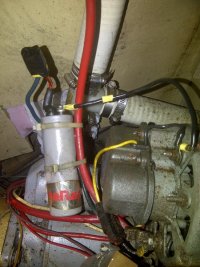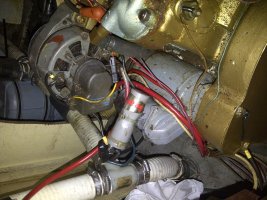You are using an out of date browser. It may not display this or other websites correctly.
You should upgrade or use an alternative browser.
You should upgrade or use an alternative browser.
A4 part
- Thread starter steven
- Start date
Dave Neptune
Member II
A-4?
Steve, that is not an A-4 part. It looks like it could be a valve or a pump of some sort. Your 35 has the engine under the cockpit I assume form the pic. The white hose is part of the sink/cockpit drain system and would not be attached to the engine. There are quite a few A-4's with electric water pumps when converter to fresh water cooling however that does not look like a pump from the angle of the pic. It could be an ultra violet sanitizer but why would it be there?
Dave Neptune
Steve, that is not an A-4 part. It looks like it could be a valve or a pump of some sort. Your 35 has the engine under the cockpit I assume form the pic. The white hose is part of the sink/cockpit drain system and would not be attached to the engine. There are quite a few A-4's with electric water pumps when converter to fresh water cooling however that does not look like a pump from the angle of the pic. It could be an ultra violet sanitizer but why would it be there?
Dave Neptune
tenders
Innocent Bystander
If it is really wired into the electrical system, I'm guessing that it's a giant capacitor designed to suppress ignition noise. Probably a vestige from the days of Loran navigation systems, and not necessary these days--and probably more trouble than it was worth even then.
Perhaps it's a very early attempt at a Flux Gate Capacitor...
If you set your engine controls exactly right, your boat transports you back to 1976 !
:0
LB
If you set your engine controls exactly right, your boat transports you back to 1976 !
:0
LB
Dave Neptune
Member II
Good eye & memory
Hey tenders how you been? I think you may of hit this one on the head, it does look like a capasitor just sitting there. Can't really tell if it's hooked in to the plumbing so your probably right on trac.
Dave Neptune
Hey tenders how you been? I think you may of hit this one on the head, it does look like a capasitor just sitting there. Can't really tell if it's hooked in to the plumbing so your probably right on trac.
Dave Neptune
mherrcat
Contributing Partner
Danger Will Robinson!!
If that is a "giant capacitor" as has been suggested, I would DEFINITELY NOT be trying to disconnect it without verifying that it is a capacitor and DISCHARGING it safely and completely before handling it.
Capacitors can store thousands of volts for long periods of time and can KILL YOU if it discharges through you.
I have several tube-type guitar amplifiers and discharging the filter caps is a standard warning before doing any work on them.
Here's a quick video of a capacitor being discharged by shorting:
http://www.youtube.com/watch?v=F7uIN5lyuZw
If that is a "giant capacitor" as has been suggested, I would DEFINITELY NOT be trying to disconnect it without verifying that it is a capacitor and DISCHARGING it safely and completely before handling it.
Capacitors can store thousands of volts for long periods of time and can KILL YOU if it discharges through you.
I have several tube-type guitar amplifiers and discharging the filter caps is a standard warning before doing any work on them.
Here's a quick video of a capacitor being discharged by shorting:
http://www.youtube.com/watch?v=F7uIN5lyuZw
Last edited:
You forgot the smileys!



















Do not touch your tongue to that capacitor!!!!!
Tenders is asking you to pee on that electric fence again isn't he!





Don't be a wuss. Put your tongue across the terminals and take the spark like a man.



















Do not touch your tongue to that capacitor!!!!!
Tenders is asking you to pee on that electric fence again isn't he!





steven
Sustaining Member
As soon as the engine is back in service (some repairs and upgrades are underway right now), I will try (carefully) disconnecting it and see if anything goes wrong. Looks like a capacitor to me too. it is only connected to wires at one end. If I end up in 1947 or something I will put a note to the Ericson club in a bottle in hopes it will wash up in the then future and someone will find it and post it.
--Steve
--Steve
mherrcat
Contributing Partner
I would try to trace the wiring before disconnecting anything. Since the A4 has spark plugs and a distributor, it could be the ignition coil that was moved from its original location for some reason.
If it is a capacitor there is a safe way to discharge it to ground using a wire with a resistor attached to it. Don't recall what the value of the resistor needs to be. The resistor allows the charge to drain slowly rather than all at once with a huge pop and spark.
Here's a video of a guy checking the caps on an amp. The resistor he is using might be too small for your purposes, though.
http://www.youtube.com/watch?v=Rg3-dZC5Fww
Here's my disclaimer: I am not responsible if you electrocute yourself.
If it is a capacitor there is a safe way to discharge it to ground using a wire with a resistor attached to it. Don't recall what the value of the resistor needs to be. The resistor allows the charge to drain slowly rather than all at once with a huge pop and spark.
Here's a video of a guy checking the caps on an amp. The resistor he is using might be too small for your purposes, though.
http://www.youtube.com/watch?v=Rg3-dZC5Fww
Here's my disclaimer: I am not responsible if you electrocute yourself.
steven
Sustaining Member
Here is another pic showing the mystery device and alternator (southeast quadrant of the picture).
There are only two wires connected to the thing, both at it's top.
The black wire that goes to the right terminates at the alternator near the right edge of the picture..
The red wire that goes up is spliced to the blue vertical that then goes down (behind the device in the picture) to another alternator terminal near the bottom right of the pic (where several other red wires from other things terminate).
Does this support the theory that it is a capacitor?
Why would a capacitor by strapped across an alternator?

Thanks for everyone's continued help.
--Steve
There are only two wires connected to the thing, both at it's top.
The black wire that goes to the right terminates at the alternator near the right edge of the picture..
The red wire that goes up is spliced to the blue vertical that then goes down (behind the device in the picture) to another alternator terminal near the bottom right of the pic (where several other red wires from other things terminate).
Does this support the theory that it is a capacitor?
Why would a capacitor by strapped across an alternator?

Thanks for everyone's continued help.
--Steve
mherrcat
Contributing Partner
Maybe a silly question, but do you know that this part is actually causing a problem of some kind? (It now looks clearly like a capacitor as an ignition coil would have a connection to the distributor.) It seems likely that it was installed to solve a problem at one time, as why would one install a part like that for no reason? If it isn't causing any problems why not just leave it alone?
It would concern me a little that the body of the capacitor looks to be somewhat crushed, but if it is still functioning...
It would concern me a little that the body of the capacitor looks to be somewhat crushed, but if it is still functioning...
tenders
Innocent Bystander
The purpose of these things in the 80s was to absorb electromagnetic noise coming from voltage spikes in the ignition system. The opening and closing of the points, and the jumping of the spark, several thousand times a minute would interfere with Loran navigation systems and cause them to lose their fixes. The noise is related to the buzzing you hear on the AM radio band that changes with engine RPM.
These days, apparently some fluorescent fixtures do the same thing to GPS signals but I haven't observed it myself.
These days, apparently some fluorescent fixtures do the same thing to GPS signals but I haven't observed it myself.


